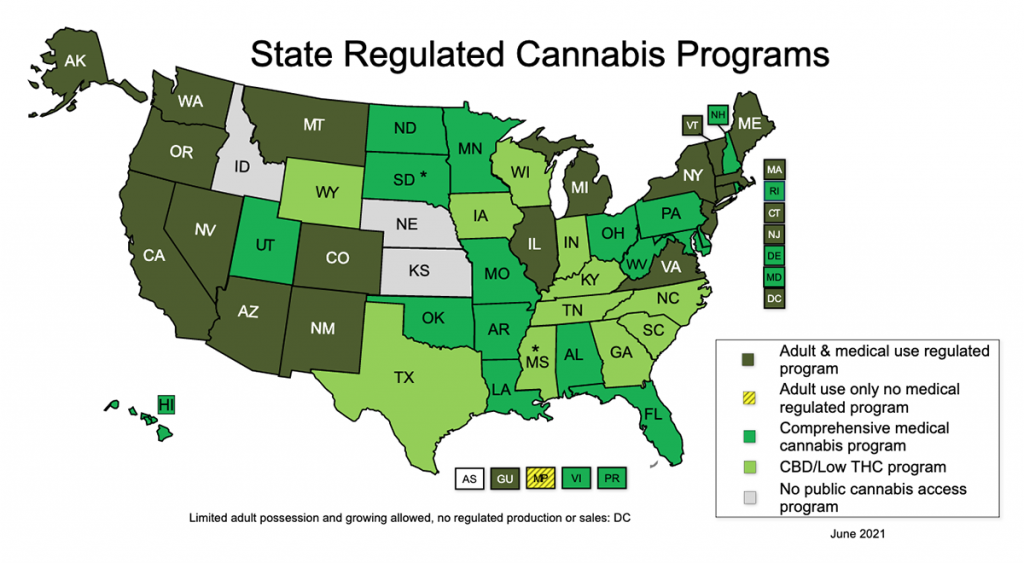Relieving Cancer Treatment Side Effects With Pot
- About 40% of breast cancer patients use cannabis, according to a recent survey, and most patients who use the drug report doing so to relieve symptoms associated with treatment.
- In the U.S., 36 states and four territories have medical marijuana programs. In states that don't, people facing severe side effects don't have the option to alleviate pain with cannabis at least not legally.
- Humans have a natural cannabis system that our bodies create. But when a person is in chronic pain, these natural pain relievers aren't enough. That’s when cannabis comes into play.
Between Dec. 16, 2019, and Jan. 19, 2020, the Coala-T-Cannabis study surveyed people with a self-reported breast cancer diagnosis who were also members of online health communities Breastcancer.org and Healthline.com. In total, 612 people completed the survey, 257 (42%) of whom reported using cannabis to address medical issues associated with their cancer.
Read MoreIf you're a cancer patient considering cannabis use for treatment-related symptoms, here are five tips on how to do so:
5 Tips on How to Use Cannabis For Cancer
- Tell your doctor that you're using cannabis. "I think that you should always tell whichever therapy we're talking about, you should always inform your oncologist and your physician this is (using cannabis) what you're doing," Dr. Brian Berman, professor of family community medicine at the University of Maryland School of Medicine, tells SurvivorNet. Dr. Berman says that doctors estimate about 60% to 80% of cancer patients are using some form of complementary, integrative approach. But only about 30% to 40% are telling their physicians about it.
- Do your research. First of all, see if you live in a state where medical marijuana is legal. If so, figure out how to obtain a card to legally smoke the drug.
- Get a medical marijuana card. If you live in a U.S. state or territory where medical marijuana is legal, look into how to apply for a card, as every state and its own guidelines and requirements.
- Expect some trial and error when first trying out cannabis use. Like cancer drugs, not everything works for everyone. The same goes for cannabis; one type may work great for you, but not someone else. If the first kind you try doesn't do the trick, try others.
- Don't think of cannabis as a cure. SurvivorNet experts don't advise against the use of medical marijuana, but our experts say that nontraditional approaches should never replace medical treatments backed by science.
Gaining Access to Medical Marijuana
In the United States, 36 states, the District of Columbia, Guam, Puerto Rico and the U.S. Virgin Islands have approved comprehensive, publicly available medical marijuana/cannabis programs, according to the National Conference of State Legislatures. (Recreational marijuana use is legal in 19 U.S. states, Washington, D.C., and Guam. Cannabis still remains illegal on a federal level.)
This means that people facing a lot of pain whether or not that pain is associated with cancer treatment in these states have access to a quality product that's tightly regulated by state governments, Dr. Junella Chin, an integrative cannabis physician in New York, tells SurvivorNet. In states that don't have medical marijuana programs, people facing severe side effects don't have the option to alleviate some of the pain with cannabis at least not legally.
Who Has Access to Medical Marijuana in the U.S.?
"In the New York model, I sleep better at night because I know my patients are getting organic products, solvent-free, they don't have mold or fungus in (them)," Dr. Chin says. "They're meeting with a pharmacist, everything is getting documented so I can follow (up) on how much they're picking up and what they're picking up."
For patients living in states without medical marijuana programs, they have to resort to the black market, Dr. Chin says, "but you just don't know what you're getting."
Each state has its own requirements for obtaining a medical marijuana card. If you live in a state where medical marijuana use is legal and you think it might be the right treatment for you, start by talking to your doctor.

Relieving Cancer Treatment Side Effects With Pot
"Medical cannabis, if you think about it it's the only botanical medicine that can help nausea, increase appetite, decrease pain, and elevate mood," Dr. Chin says.
She says that people come to her seeking relief for all types of chemo-related ailments, such as nausea, decreased appetite, pain, insomnia or depression all of which she says cannabis can help with. There are some physicians who will prescribe Marinol, or synthetic cannabis, to treat these side effects as well. But Dr. Chin says using the actual cannabis plant is much more helpful.
Treating Chemo Side Effects With Cannabis
"That (the actual plant) is much more effective in increasing appetite and decreasing pain for my cancer patients," Dr. Chin says.
But how exactly does cannabis alleviate pain in the human body? Dr. Chin explains that humans have a natural cannabis system, or an endocannabinoid system, that our bodies create. But when a person is in chronic pain, these natural pain relievers just aren't enough.
"When we utilize phytocannabinoids from the cannabis plant, we are actually replenishing our body's own cannabinoid system," she says. "By doing so, it helps us deal with pain and inflammation much more effectively."
Learn more about SurvivorNet's rigorous medical review process.

